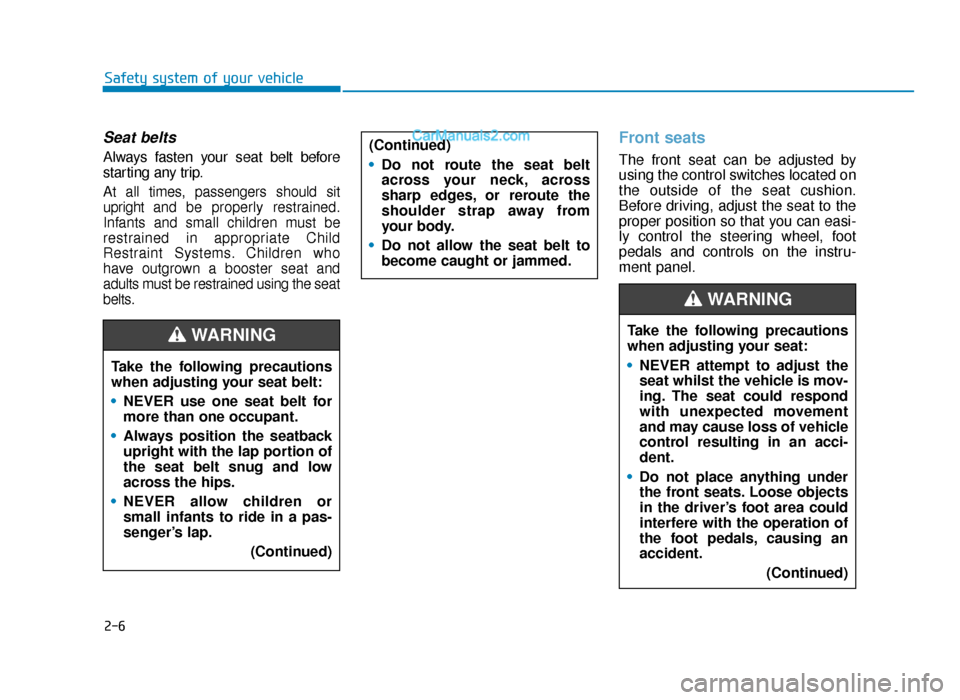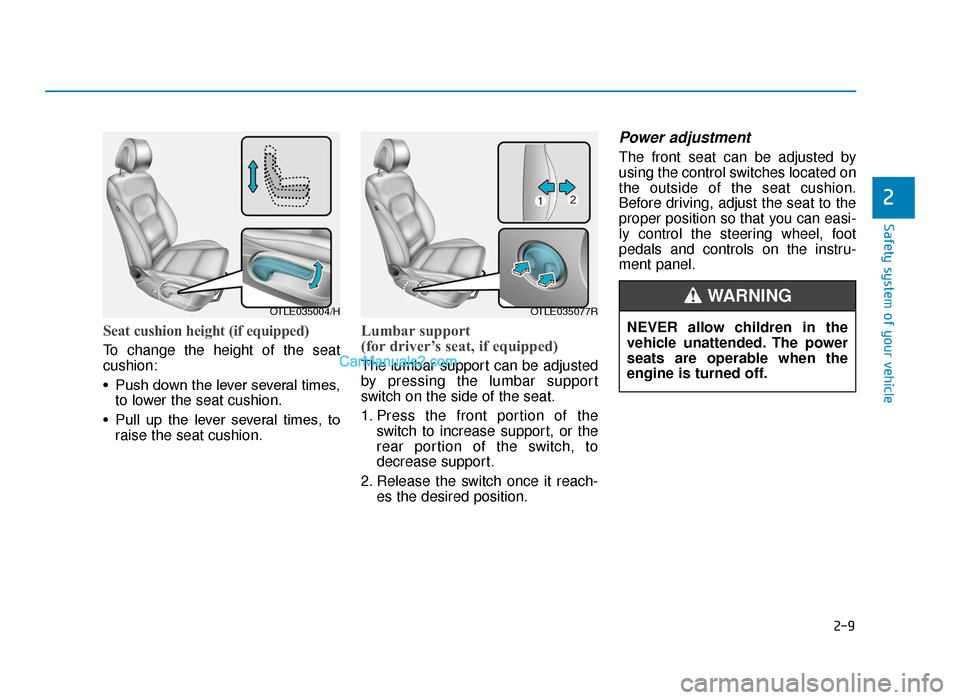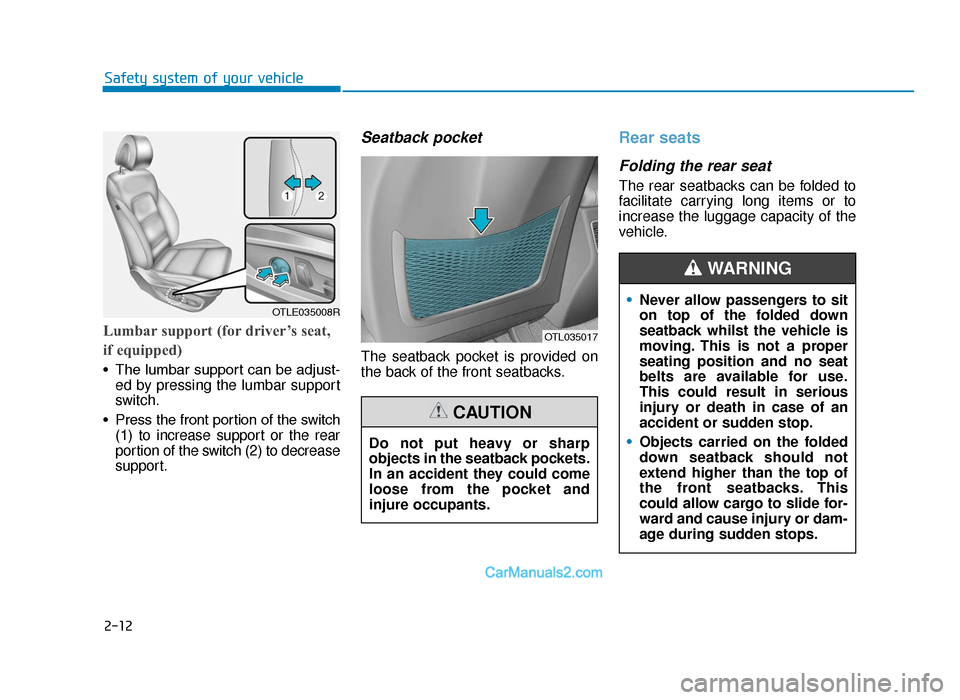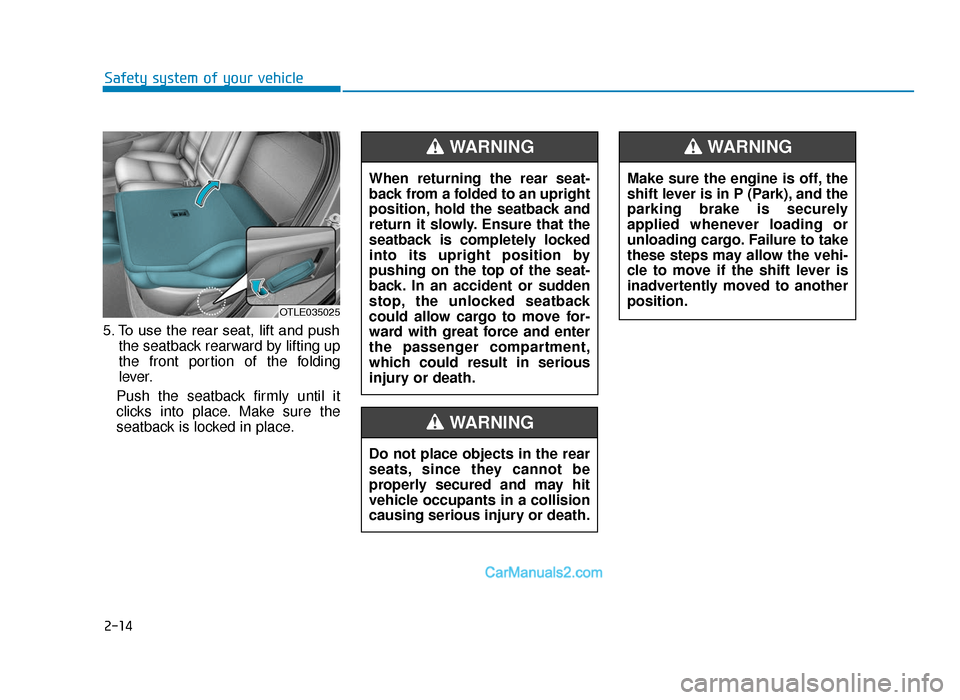2019 Hyundai Tucson warning
[x] Cancel search: warningPage 22 of 685

2-2
You will find many safety precautions
and recommendations throughout
this section, and throughout this
manual. The safety precautions in
this section are among the most
important.
Always wear your seat belt
A seat belt is your best protection in
all types of accidents. Air bags are
designed to supplement seat belts,
not replace them. So even though
your vehicle is equipped with air
bags, ALWAYS make sure you and
your passengers wear your seat
belts, and wear them properly.
Restrain all children
All children under age 13 should ride
in your vehicle properly restrained in
a rear seat, not the front seat. Infants
and small children should be
restrained in an appropriate Child
Restraint System. Larger children
should use a booster seat with the
lap/shoulder belt until they can use
the seat belt properly without a
booster seat.
Air bag hazards
Whilst air bags can save lives, they
can also cause serious or fatal
injuries to occupants who sit too
close to them, or who are not prop-
erly restrained. Infants, young chil-
dren, and short adults are at the
greatest risk of being injured by an
inflating air bag. Follow all instruc-
tions and warnings in this manual.
Driver distraction
Driver distraction presents a serious
and potentially deadly danger, espe-
cially for inexperienced drivers.
Safety should be the first concern
when behind the wheel and drivers
need to be aware of the wide array of
potential distractions, such as
drowsiness, reaching for objects,
eating, personal grooming, other
passengers, and using mobile
phones.
Drivers can become distracted when
they take their eyes and attention off
the road or their hands off the wheel
to focus on activities other than driv-
ing. To reduce your risk of distraction
and an accident:
• ALWAYS set up your mobiledevices (i.e., MP3 players, phones,
navigation units, etc.) when your
vehicle is parked or safely stopped.
• ONLY use your mobile device when allowed by laws and condi-
tions permit safe use. NEVER text
or email whilst driving. Most coun-
tries have laws prohibiting drivers
from texting. Some countries and
cities also prohibit drivers from
using handheld phones.
IMPORTANT SAFETY PRECAUTIONS
Safety system of your vehicle
TLe UK 2.qxp 6/12/2018 2:03 PM Page 2
Page 25 of 685

2-5
Safety system of your vehicle
2
Safety precautions
Adjusting the seats so that you are
sitting in a safe, comfortable position
plays an important role in driver and
passenger safety together with the
seat belts and air bags in an acci-
dent.
Air bags
You can take steps to reduce the risk
of being injured by an inflating air
bag. Sitting too close to an air bag
greatly increases the risk of injury in
the event the air bag inflates. Move
your seat as far back as possible
from front air bags, whilst still main-
taining control of the vehicle.To reduce the risk of serious
injury or death from an inflating
air bag, take the following pre-
cautions:
• Adjust the driver’s seat as far
to the rear as possible main-
taining the ability to control of
the vehicle.
• Adjust the front passenger
seat as far to the rear as pos-
sible.
(Continued)
WARNING
(Continued)
•Hold the steering wheel by the
rim with hands at the 9 o’clock
and 3 o’clock positions to
minimise the risk of injuries to
your hands and arms.
• NEVER place anything or any-
one between the air bag.
• Do not allow the front passen-
ger to place feet or legs on the
dashboard to minimise the
risk of leg injuries.
Do not use a cushion that
reduces friction between the
seat and the passenger. The
passenger's hips may slide
under the lap portion of the seat
belt during an accident or a
sudden stop.
Serious or fatal internal injuries
could result because the seat
belt cannot operate properly.
WARNING
TLe UK 2.qxp 6/12/2018 2:03 PM Page 5
Page 26 of 685

2-6
Safety system of your vehicle
Seat belts
Always fasten your seat belt before
starting any trip.
At all times, passengers should sit
upright and be properly restrained.
Infants and small children must be
restrained in appropriate Child
Restraint Systems. Children who
have outgrown a booster seat and
adults must be restrained using the seat
belts.
Front seats
The front seat can be adjusted by
using the control switches located on
the outside of the seat cushion.
Before driving, adjust the seat to the
proper position so that you can easi-
ly control the steering wheel, foot
pedals and controls on the instru-
ment panel.
Take the following precautions
when adjusting your seat belt:
• NEVER use one seat belt for
more than one occupant.
• Always position the seatback
upright with the lap portion of
the seat belt snug and low
across the hips.
• NEVER allow children or
small infants to ride in a pas-
senger’s lap.
(Continued)(Continued)
•Do not route the seat belt
across your neck, across
sharp edges, or reroute the
shoulder strap away from
your body.
• Do not allow the seat belt to
become caught or jammed.
WARNING Take the following precautions
when adjusting your seat:
•NEVER attempt to adjust the
seat whilst the vehicle is mov-
ing. The seat could respond
with unexpected movement
and may cause loss of vehicle
control resulting in an acci-
dent.
• Do not place anything under
the front seats. Loose objects
in the driver’s foot area could
interfere with the operation of
the foot pedals, causing an
accident.
(Continued)
WARNING
TLe UK 2.qxp 6/12/2018 2:03 PM Page 6
Page 28 of 685

2-8
Seatback angle
To recline the seatback:
1. Roll the seatback knob rearward.
2. Carefully lean back on the seatand adjust the seatback to the
position you desire.
3. Release the knob and make sure the seatback is locked in place. Reclining seatback
Sitting in a reclined position when
the vehicle is in motion can be dan-
gerous. Even when buckled up, the
protections of your restraint system
(seat belts and/or air bags) is greatly
reduced by reclining your seatback.
Seat belts must be snug against your
hips and chest to work properly.
When the seatback is reclined, the
shoulder belt cannot do its job
because it will not be snug against
your chest. Instead, it will be in front
of you. During an accident, you could
be thrown into the seat belt, causing
neck or other injuries.
The more the seatback is reclined,
the greater chance the passenger’s
hips will slide under the lap belt or
the passenger’s neck will strike the
shoulder belt.
Safety system of your vehicle
OTLE035003/HNEVER ride with a reclined
seatback when the vehicle is
moving.
Riding with a reclined seatback
increases your chance of seri-
ous or fatal injuries in the event
of a collision or sudden stop.
Drivers and passengers should
ALWAYS sit well back in their
seats, properly belted, and with
the seatbacks upright.
WARNING
TLe UK 2.qxp 6/12/2018 2:03 PM Page 8
Page 29 of 685

2-9
Safety system of your vehicle
Seat cushion height (if equipped)
To change the height of the seat
cushion:
• Push down the lever several times,to lower the seat cushion.
• Pull up the lever several times, to raise the seat cushion.
Lumbar support
(for driver’s seat, if equipped)
The lumbar support can be adjusted
by pressing the lumbar support
switch on the side of the seat.
1. Press the front portion of the switch to increase support, or the
rear portion of the switch, to
decrease support.
2. Release the switch once it reach- es the desired position.
Power adjustment
The front seat can be adjusted by
using the control switches located on
the outside of the seat cushion.
Before driving, adjust the seat to the
proper position so that you can easi-
ly control the steering wheel, foot
pedals and controls on the instru-
ment panel.
2
OTLE035004/HOTLE035077R
NEVER allow children in the
vehicle unattended. The power
seats are operable when the
engine is turned off.
WARNING
TLe UK 2.qxp 6/12/2018 2:03 PM Page 9
Page 31 of 685

2-11
Safety system of your vehicle
2
Reclining seatback
Sitting in a reclined position when
the vehicle is in motion can be dan-
gerous. Even when buckled up, the
protections of your restraint system
(seat belts and air bags) is greatly
reduced by reclining your seatback.Seat belts must be snug against your
hips and chest to work properly.
When the seatback is reclined, the
shoulder belt cannot do its job
because it will not be snug against
your chest. Instead, it will be in front
of you. During an accident, you could
be thrown into the seat belt, causing
neck or other injuries.
The more the seatback is reclined,
the greater chance the passenger’s
hips will slide under the lap belt or
the passenger’s neck will strike the
shoulder belt.
Seat cushion height (if equipped)
To change the height of the seat cush-
ion:
1. • Push the front portion of the con-
trol switch up to raise or down to
lower the front part of the seat
cushion.
• Push the rear portion of the con- trol switch up to raise or down to
lower the height of the seat cush-
ion.
2. Release the switch once the seat reaches the desired position.
NEVER ride with a reclined
seatback when the vehicle is
moving.
Riding with a reclined seatback
increases your chance of seri-
ous or fatal injuries in the event
of a collision or sudden stop.
Driver and passengers should
ALWAYS sit well back in their
seats, properly belted, and with
the seatbacks upright.
WARNING
OTL035051/H
TLe UK 2.qxp 6/12/2018 2:03 PM Page 11
Page 32 of 685

2-12
Safety system of your vehicle
Lumbar support (for driver’s seat,
if equipped)
• The lumbar support can be adjust-ed by pressing the lumbar support
switch.
• Press the front portion of the switch (1) to increase support or the rear
portion of the switch (2) to decrease
support.
Seatback pocket
The seatback pocket is provided on
the back of the front seatbacks.
Rear seats
Folding the rear seat
The rear seatbacks can be folded to
facilitate carrying long items or to
increase the luggage capacity of the
vehicle.
Do not put heavy or sharp
objects in the seatback pockets.
In an accident they could come
loose from the pocket and
injure occupants.
CAUTION
OTL035017
OTLE035008R• Never allow passengers to sit
on top of the folded down
seatback whilst the vehicle is
moving. This is not a proper
seating position and no seat
belts are available for use.
This could result in serious
injury or death in case of an
accident or sudden stop.
• Objects carried on the folded
down seatback should not
extend higher than the top of
the front seatbacks. This
could allow cargo to slide for-
ward and cause injury or dam-
age during sudden stops.
WARNING
TLe UK 2.qxp 6/12/2018 2:04 PM Page 12
Page 34 of 685

2-14
5. To use the rear seat, lift and pushthe seatback rearward by lifting up
the front portion of the folding
lever.
Push the seatback firmly until it
clicks into place. Make sure the
seatback is locked in place.
Safety system of your vehicle
OTLE035025
Do not place objects in the rear
seats, since they cannot be
properly secured and may hit
vehicle occupants in a collision
causing serious injury or death.
WARNING
When returning the rear seat-
back from a folded to an upright
position, hold the seatback and
return it slowly. Ensure that the
seatback is completely locked
into its upright position by
pushing on the top of the seat-
back. In an accident or sudden
stop, the unlocked seatback
could allow cargo to move for-
ward with great force and enter
the passenger compartment,
which could result in serious
injury or death.
WARNING
Make sure the engine is off, the
shift lever is in P (Park), and the
parking brake is securely
applied whenever loading or
unloading cargo. Failure to take
these steps may allow the vehi-
cle to move if the shift lever is
inadvertently moved to another
position.
WARNING
TLe UK 2.qxp 6/12/2018 2:04 PM Page 14